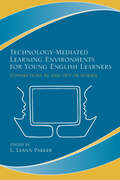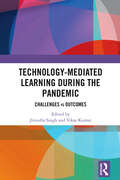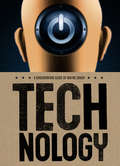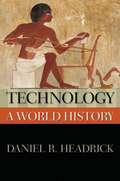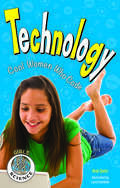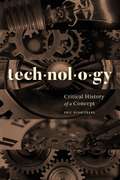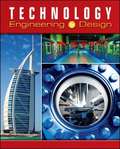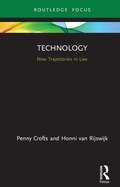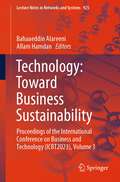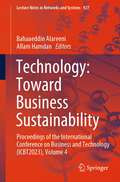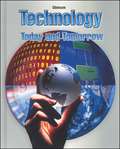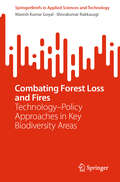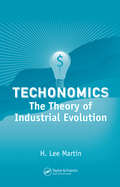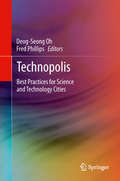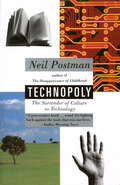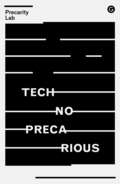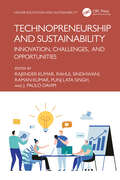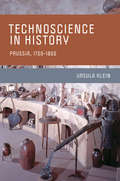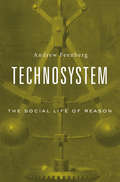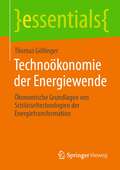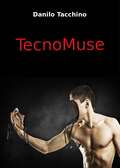- Table View
- List View
Technology-Mediated Learning Environments for Young English Learners: Connections In and Out of School
by L. Leann ParkerThis book explores issues related to the use of technologies to support young second-language learners and looks at promising areas for research, design, and development. Grounded in a sociocultural theoretical framework, it invites educators, researchers, and educational technology developers to consider a range of social and cultural factors in utilizing technology as a tool to help children from diverse linguistic and cultural backgrounds develop their English-language and reading skills. A major contribution is the authors’ consideration of ways that technology outside of school can benefit these students’ English-language development in school. The central chapters are counter pointed by invited reflections that bring to the discussion different, yet complementary, perspectives from notable scholars in the field of second-language literacy and learning.Technology-Mediated Learning Environments for Young English-Language Learners is targeted to researchers, educators, and policymakers in the areas of elementary education, after-school learning, second-language teaching and learning, English language and literacy development, and reading.
Technology-mediated Learning During the Pandemic: Challenges vs Outcomes
by Vikas Kumar Jitendra SinghThis volume discusses the emergence of information and communication technology (ICT)-based teaching and learning during the Covid-19 pandemic as a potential alternative to traditional classroom-based learning. It presents a collection of theories, practices, and case studies from across the globe and covers different aspects of education from a multidisciplinary perspective.While focusing on the various opportunities that surfaced while carrying out innovative experiments in the online learning space, the book discusses pedagogical challenges and the need for a shift in teaching pedagogy towards online learning. It outlines the existing learning theories, reasons behind their failure, and new theories that emerged to fill the need for new methods for delivery of content and pedagogy. The book discusses the issues faced by stakeholders, including institute administrators, students, and teachers to prepare for this new method of teaching and learning. It highlights the role of virtual laboratories in supplementing the needs of students in the remote learning environment. The book also discusses the role and impact of social media as a powerful tool of learning and educational communication.This book will be of interest to teachers, students, and researchers of education, higher education, digital education, information technology, educational psychology, and media studies. It will also be useful for courses on e-learning, educationalists, policymakers, educational institutions, online education centres, and practitioners working in the related areas.
Technology: A Groundwork Guide (Groundwork Guides)
by Wayne GradyA sweeping history of technology’s advance that raises the crucial question of whether we are in control of technology, or whether technology controls us. An excellent introduction to technology for young adults.There is no doubt that we have come to rely on technology, not only for our comfort and convenience, but for our very survival as a species. A hundred and fifty years ago, Charles Darwin noted wryly that if the human species were returned to the wild without the advantage of technology, we would become extinct in six weeks.Since that time, technology has proliferated to the extent that we can no longer conceive of life without it. As this book shows, technology is more than the sum of the tools we use, whether they are primitive ploughs or space shuttles. It is a way of seeing the world, the way we determine how the world works -- technology is a way of thinking.We see this in the way technology has invaded our language: we speak of the education system, the cultural industry. Since the 18th century, we have tended to describe the universe as a giant clockwork, the body as a machine, and, more recently, the mind as a computer. These are all aspects of the degree to which we have come to live in a technological age."[The Groundwork Guides] are excellent books, mandatory for school libraries and the increasing body of young people prepared to take ownership of the situations and problems previous generations have left them." — Globe and Mail
Technology: A World History (The New Oxford World History)
by Daniel R. HeadrickIt offers an illuminating backdrop to our present moment--a brilliant history of invention around the globe. Historian Daniel R. Headrick ranges from the Stone Age and the beginnings of agriculture to the Industrial Revolution and the electronic revolution of the recent past. In tracing the growing power of humans over nature through increasingly powerful innovations, he compares the evolution of technology in different parts of the world, providing a much broader account than is found in other histories of technology.
Technology: Cool Women who Code
by Andi DiehnDo you listen to music with an MP3 player or read books on a tablet? Do you play multiplayer video games with people on the other side of the world? Do you have a robot cleaning your kitchen? Maybe not yet, but someday! In Technology: Cool Women Who Code, kids in grades four through six learn about the thrilling effort that goes into researching, inventing, programming, and producing the technology we use today, from iPods to mechanical limbs. Young readers discover exactly what technology is, how it evolved, and where the future may lead. They also meet three women who have contributed to the field in critical ways, including Grace Hopper and Shaundra Bryant Daily. Technology: Cool Women Who Code combines high-interest content with links to online primary sources and essential questions that further expand kids’ knowledge and understanding of a topic they come in contact with every day. Compelling portraits of women who have excelled in meeting the challenges of their field keep kids interested and infused with a sense of possibility and determination.
Technology: Critical History of a Concept
by Eric SchatzbergIn modern life, technology is everywhere. Yet as a concept, technology is a mess. In popular discourse, technology is little more than the latest digital innovations. Scholars do little better, offering up competing definitions that include everything from steelmaking to singing. In Technology: Critical History of a Concept, Eric Schatzberg explains why technology is so difficult to define by examining its three thousand year history, one shaped by persistent tensions between scholars and technical practitioners. Since the time of the ancient Greeks, scholars have tended to hold technicians in low esteem, defining technical practices as mere means toward ends defined by others. Technicians, in contrast, have repeatedly pushed back against this characterization, insisting on the dignity, creativity, and cultural worth of their work. The tension between scholars and technicians continued from Aristotle through Francis Bacon and into the nineteenth century. It was only in the twentieth century that modern meanings of technology arose: technology as the industrial arts, technology as applied science, and technology as technique. Schatzberg traces these three meanings to the present day, when discourse about technology has become pervasive, but confusion among the three principal meanings of technology remains common. He shows that only through a humanistic concept of technology can we understand the complex human choices embedded in our modern world.
Technology: Engineering & Design (6th edition)
by James F. Fales Sharon A. Brusic Vincent F. Kuetemeyer"Technology: Engineering & Design" helps students understand and apply technology presented in an engineering context. It describes the engineering design process and how it is used to solve technological challenges. In this program students explore the nature of technology, technology systems, and the history, evolution, and characteristics of technology as well as its impact on our society, culture, economy, politics, and environment.
Technology: New Trajectories in Law (New Trajectories in Law)
by Penny Crofts Honni van RijswijkPlacing contemporary technological developments in their historical context, this book argues for the importance of law in their regulation. Technological developments are focused upon overcoming physical and human constraints. There are no normative constraints inherent in the quest for ongoing and future technological development. In contrast, law proffers an essential normative constraint. Just because we can do something, does not mean that we should. Through the application of critical legal theory and jurisprudence to pro-actively engage with technology, this book demonstrates why legal thinking should be prioritised in emerging technological futures. This book articulates classic skills and values such as ethics and justice to ensure that future and ongoing legal engagements with socio-technological developments are tempered by legal normative constraints. Encouraging them to foreground questions of justice and critique when thinking about law and technology, the book addresses law students and teachers, lawyers and critical thinkers concerned with the proliferation of technology in our lives.
Technology: Proceedings of the International Conference on Business and Technology (ICBT2023), Volume 3 (Lecture Notes in Networks and Systems #925)
by Allam Hamdan Bahaaeddin AlareeniThis book proceedings addresses a crucial gap in understanding the impact of technology on Business Model Innovation (BMI). It emphasizes the need for further research to explore the intricate relationship between technology and BMI, focusing on opportunities and challenges. By delving into how technology influences emerging business model innovations and enhances operational efficiency, the publication aims to advance knowledge. Inviting diverse research methods, it sheds light on various ideas within the technology and BMI realm. Tailored for students, scholars, professionals, and policymakers, this book contributes to the evolving field of BMI and technology.
Technology: Proceedings of the International Conference on Business and Technology (ICBT2023), Volume 4 (Lecture Notes in Networks and Systems #927)
by Allam Hamdan Bahaaeddin AlareeniThis book proceedings addresses a crucial gap in understanding the impact of technology on Business Model Innovation (BMI). It emphasizes the need for further research to explore the intricate relationship between technology and BMI, focusing on opportunities and challenges. By delving into how technology influences emerging business model innovations and enhances operational efficiency, the publication aims to advance knowledge. Inviting diverse research methods, it sheds light on various ideas within the technology and BMI realm. Tailored for students, scholars, professionals, and policymakers, this book contributes to the evolving field of BMI and technology.
Technology: Shaping Our World
by John B. Gradwell Malcolm Welch Eugene MartinDesigned for use in middle school introductory technology education courses.
Technology: Today and Tomorrow (5th edition)
by James F. Fales Sharon A. Brusic Vincent F. KuetemeyerTechnology: Today and Tomorrow is a technology literacy textbook for high school. It uses the systems approach (input, process, output, feedback) to inform students about communication and bio-related technology. The text teaches students about the nature of technology and its role in our lives. It provides information about the history and evolution of technology; the characteristics of technology; and its impact on our society, culture, economy, politics and environment. Hands-on activities give students experience in designing and using technology. "Directed" activities provide step-by-step procedures. "Design and problem solving" activities guide students to use the problem-solving process to develop their own solutions. Cross-curricular activities in the Chapter Review pages relate technology to other subjects, such as science, mathematics, language arts and social studies.
Technology–Policy Interface for Combating Forest Loss and Fires (SpringerBriefs in Applied Sciences and Technology)
by Manish Kumar Goyal Shivukumar RakkasagiThis book explores Key Biodiversity Areas (KBAs) in India, addressing the challenges and proposing solutions for the conservation of these critical ecosystems. It examines the pivotal role of KBAs in biodiversity conservation and their significance in the global context, offering data-driven analyses of deforestation, habitat fragmentation, and forest loss. Utilizing open-source data, the book assesses the extent of habitat destruction, investigates the frequency and effects of fires on biodiversity and ecosystem services, and proposes actionable fire management strategies. The authors also explores the impact of artificial lighting on wildlife within KBAs, illustrating how human development alters natural habitats and offering mitigation measures. By integrating technology and policy, the book emphasizes the application of remote sensing and data analytics to develop evidence-based conservation strategies. It also charts future directions for monitoring KBAs, highlighting the potential of emerging technologies in conservation efforts.
Technomics: The Theory of Industrial Evolution (Systems Innovation Book Series)
by H. Lee MartinHave you ever wondered about the forces behind globalization, mass customization, just in time delivery, virtual companies, and perfect information? Providing a platform to understand and navigate our rapidly advancing world, Techonomics: The Theory of Industrial Evolution explains the relationship between technology, economy, and organizati
Technopolis
by Deog-Seong Oh Fred PhillipsSix years of UNESCO-World Technopolis Association workshops, held at various world cities and attended by government officials and scholars from nearly all the world's countries, have resulted in a uniquely complete collection of reports on science park and science city projects in most of those countries. These reports, of which a selected few form chapters in this book, allow readers to compare knowledge-based development strategies, practices, and successes across countries. The chapters illustrate varying levels of cooperation across government, industry, and academic sectors in the respective projects - and the reasons and philosophies underlying this variation - and resulting differences in practices and results.
Technopoly: The Surrender of Culture to Technology
by Neil PostmanIn this witty, often terrifying work of cultural criticism, the author of Amusing Ourselves to Death chronicles our transformation into a Technopoly: a society that no longer merely uses technology as a support system but instead is shaped by it--with radical consequences for the meanings of politics, art, education, intelligence, and truth.From the Trade Paperback edition.
Technoprecarious
by Precarity LabAn analysis that traces the role of digital technology in multiplying precarity.Technoprecarious advances a new analytic for tracing how precarity unfolds across disparate geographical sites and cultural practices in the digital age. Digital technologies--whether apps like Uber built on flexible labor or platforms like Airbnb that shift accountability to users--have assisted in consolidating the wealth and influence of a small number of players. These platforms have also furthered increasingly insecure conditions of work and life for racial, ethnic, and sexual minorities, women, indigenous people, migrants, and peoples in the global south. At the same time, precarity has become increasingly generalized, expanding to include even the creative class and digital producers themselves.
Technopreneurship and Sustainability: Innovation, Challenges, and Opportunities (Higher Education and Sustainability)
by J. Paulo Davim Raman Kumar Rahul Sindhwani Punj Lata Singh Rajender KumarTechnopreneurship is an advanced version of entrepreneurship that incorporates cutting-edge technologies from AI to big data into entrepreneurial activities and leads to innovative solutions to problems that previous solutions have failed to sustain in the long term. This book explains the fundamentals of developing and establishing a small one-person business or a large organization, building technological solutions, and performing effectively and efficiently. It covers all aspects of an entrepreneurial journey, guiding readers from the startup stage, growing a business, sustainability, and clarifies the role of technopreneurship as a tool to enhance sustainability in today’s entrepreneurial ventures.Features Explains the theory and the practice of entrepreneurship in today’s technological era Presents technological developments, their implementations, and the potential outcomes of technology used in entrepreneurial activities Covers sustainability and the role of technologies to achieve sustainable development goals associated with different ventures Discusses ways to minimize failures of entrepreneurial ventures especially in startups Includes real-life case studies focused on today’s problems and solutions This book is ideal for undergraduate and graduate students taking courses in Entrepreneurship and Startup as well as business consultants and business owners in any field.
Technoscience in History: Prussia, 1750-1850 (Transformations: Studies in the History of Science and Technology)
by Ursula KleinThe second edition of a comprehensive introduction to machine learning approaches used in predictive data analytics, covering both theory and practice.Machine learning is often used to build predictive models by extracting patterns from large datasets. These models are used in predictive data analytics applications including price prediction, risk assessment, predicting customer behavior, and document classification. This introductory textbook offers a detailed and focused treatment of the most important machine learning approaches used in predictive data analytics, covering both theoretical concepts and practical applications. Technical and mathematical material is augmented with explanatory worked examples, and case studies illustrate the application of these models in the broader business context.
Technosystem: The Social Life of Reason
by Andrew FeenbergWe live in a world of technical systems designed in accordance with technical disciplines and operated by technically trained personnel—a unique social organization that largely determines our way of life. Andrew Feenberg’s theory of social rationality represents both the threats of technocratic modernity and the potential for democratic change.
Technoökonomie der Energiewende: Ökonomische Grundlagen von Schlüsseltechnologien der Energietransformation (essentials)
by Thomas GöllingerDas essential behandelt die technoökonomischen Grundlagen und deren Anwendung auf die Schlüsseltechnologien der Energiewende. Zunächst erfolgt eine inhaltliche Klärung und formale Herleitung von statischen und dynamischen Skaleneffekten sowie eine Übersicht bzgl. deren unterschiedlicher Kombinationsmöglichkeiten für die Diskussion von Best- und Worst-Case-Szenarien. Für eine Anwendung dieser Grundlagen stehen zunächst die diversen brennstoffbasierten KWK-Varianten, insbesondere Blockheizkraftwerke (BHKW), im Zentrum. Anschließend erfolgt eine Ausweitung der Betrachtungen auf die regenerativen Energietechnologien Photovoltaik und Windkraft. Mit einem kurzen Blick auf weitere Technologien wie Wärmepumpen sowie elektrische und thermische Energiespeicher finden diese Darstellungen ihren Abschluss.
Tecnomuse: Technologie et poésie : un mariage incroyablement mathématique...
by Danilo TacchinoTecnomuse de Danilo Tacchino Technologie et poésie : un mariage incroyablement mathématique... Tecnomuse L'expérience des jeunes est renforcée par le moment du développement technologique dans lequel les technologies électroniques et de l'information se développent de manière exponentielle et la société mondiale s'interroge sur le développement en cours et où il peut conduire l'ensemble de la société humaine. Le nouveau défi de l'homme vers de nouveaux objectifs de connaissance et de bien-être pour l'ensemble de l'humanité est grand et plein d'illusions. De nombreuses questions, doutes et sentiments liés à ce développement de la vie sociale sont le point de départ d'un discours poétique qu'il faut affronter et sur lequel il faut se confronter.
Tecnomuse: Technologie und Poesie: eine unglaublich mathematische Ehe ...
by Danilo TacchinoTecnomuse von Danilo Tacchino Technologie und Poesie: eine unglaublich mathematische Ehe ... Tecnomuse Die Jugenderfahrung wird durch den Moment der technologischen Entwicklung verbessert, in dem die Elektronik- und Informationstechnologie exponentiell wächst und sich die Weltgesellschaft über die Entwicklung wundert, die stattfindet und wohin sie die gesamte menschliche Gesellschaft führen kann. Die neue Herausforderung des Menschen hin zu neuen Erkenntnis- und Wohlstandszielen für die gesamte Menschheit ist groß und voller Illusionen. Viele Fragen, Zweifel und Gefühle im Zusammenhang mit dieser Entwicklung des gesellschaftlichen Lebens sind Ausgangspunkt für einen poetischen Diskurs, dem man sich stellen muss und dem man sich konfrontieren muss.
Tecnomuse: Technology and Poetry: an incredibly mathematical marriage ...
by Danilo TacchinoTecnomuse by Danilo Tacchino Technology and Poetry: an incredibly mathematical marriage ... Tecnomuse The youth experience is enhanced by the moment of technological development in which electronic and information technology is growing exponentially and world society is wondering about the development that is taking place and where it can lead the entire human society. The new challenge of man towards new goals of knowledge and well-being for the whole of humanity is great and full of illusions. Many questions, doubts and feelings related to this development of social life are the starting point for a poetic discourse that must be faced and on which one must confront.
Tecnomuse: Tecnología y poesía: un matrimonio increíblemente matemático ...
by Danilo TacchinoTecnomuse de Danilo Tacchino Tecnología y poesía: un matrimonio increíblemente matemático ... Tecnomuse La experiencia de los jóvenes se ve reforzada por el momento del desarrollo tecnológico en el que la tecnología electrónica y de la información está creciendo exponencialmente y la sociedad mundial se pregunta sobre el desarrollo que está teniendo lugar y hacia dónde puede conducir a toda la sociedad humana. El nuevo desafío del hombre hacia nuevas metas de conocimiento y bienestar para toda la humanidad es grande y está lleno de ilusiones. Numerosas preguntas, dudas y sentimientos relacionados con este desarrollo de la vida social son el punto de partida de un discurso poético que hay que afrontar y sobre el que hay que confrontar.
